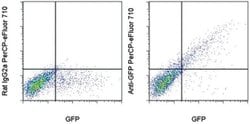Learn More
Invitrogen™ GFP Monoclonal Antibody (5F12.4), PerCP-eFluor™ 710, eBioscience™
Rat Monoclonal Antibody
Supplier: Invitrogen™ 46649880

Description
Description: This 5F12.4 monoclonal antibody reacts with green-fluorescent protein (GFP), which was originally isolated from the cnidarian Aequorea victoria. This protein absorbs blue light (maximally at 395 nm) and emits green light (peak at 509) without the requirement of exogenous substrates and cofactors. These unique qualities allow GFP to be used to monitor gene expression and protein localization in vivo. Several mutant forms of GFP have been developed which fluoresce more intensely and have shifted excitation maxima when compared to wildtype GFP, making them useful for flow cytometry, fluorescence microscopy, and double-labeling applications. This antibody is capable of staining formaldehyde fixed cells. Applications Reported: This 5F12.4 antibody has been reported for use in flow cytometric analysis. Applications Tested: This 5F12.4 antibody has been tested by intracellular staining and flow cytometric analysis of GFP transfected cells. This can be used at less than or equal to 0.125 μg per test. A test is defined as the amount (μg) of antibody that will stain a cell sample in a final volume of 100 μL. Cell number should be determined empirically but can range from 10^5 to 10^8 cells/test. It is recommended that the antibody be carefully titrated for optimal performance in the assay of interest. PerCP-eFluor® 710 emits at 710 nm and is excited with the blue laser (488 nm); it can be used in place of PerCP-Cyanine5.5. We recommend using a 710/50 bandpa...
The jellyfish Aequorea victoria contains green fluorescent protein (GFP Tag) that emits light in the bioluminescence reaction of the animal. GFP has been used widely as a reporter protein for gene expression in eukaryotic and prokaryotic organisms, and as a protein tag in cell culture and in multicellular organisms. As a fusion tag, GFP can be used to localize proteins, to study their movement or to research the dynamics of the subcellular compartments where these proteins are targeted. GFP technology has revealed considerable new insights in the physiological activities of living cells. GFP is a 27 kDa monomeric protein, which autocatalytically forms a fluorescent pigment. The wild type protein absorbs blue light (maximally at 395nm) and emits green light (peak emission 508nm) in the absence of additional proteins, substrates, or co-factors. GFP fluorescence is stable, species independent and is suitable for a variety of applications. GFP has been used extensively as a fluorescent tag to monitor gene expressin and protein localization. Moreover, other applications for GFP include its use in assessing protein protein interactions in the yeast two hybrid system, and in measuring distances between proteins in fluorescence energy transfer (FRET) experiments.
Specifications
| GFP | |
| Monoclonal | |
| 0.2 mg/mL | |
| PBS with 0.09% sodium azide; pH 7.2 | |
| Rat | |
| 25 μg | |
| Primary | |
| 4°C, store in dark, DO NOT FREEZE! | |
| Liquid | |
| Tag |
| Flow Cytometry | |
| 5F12.4 | |
| PerCP-eFluor 710 | |
| GFP; GFP tag; GFP2; green fluorescence; green fluorescent; Turbo eGFP | |
| Affinity chromatography | |
| RUO | |
| Tag | |
| Antibody | |
| IgG2a κ |
The Fisher Scientific Encompass Program offers items which are not part of our distribution portfolio. These products typically do not have pictures or detailed descriptions. However, we are committed to improving your shopping experience. Please use the form below to provide feedback related to the content on this product.
